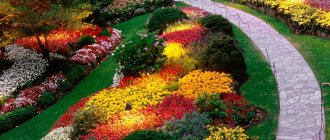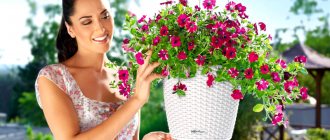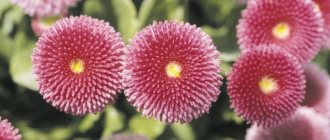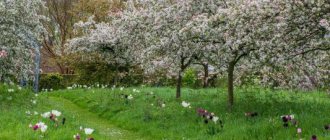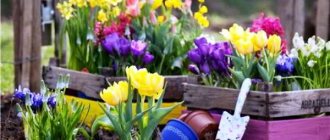You are in the ampelous , the large indoor section contains the following plants: episcia, callisia, acalypha, stephanotis, alsobia, campanula, dipladenia, syngonium, rhipsalis, mandevilla, dichondra, bacopa, aeschynanthus, tradescantia.
Ampelous plants are always held in high esteem by flower lovers. First of all, due to its original appearance.
Increased branching allows them to be formed into balls, ovals and other intricate shapes that can be used in interior design: to decorate residential and office premises, terraces and loggias, facades and foyers. However, do not rush to go shopping at the store - first learn the rules for caring for them.
Kinds
Ampelous plants for the garden, which can be planted in hanging pots, surprise with their diversity. The most common of them are:
- Petunia is the queen of ampelous flowers. Besides warmth and sun, she doesn’t really need anything else. Although an annual, it is very loved by gardeners;
- ampelous fuchsia is very spectacular, its flowers are small but bright;
- Surfinia is often called petunia; its flowers are similar, but smaller. Shoots can reach up to 1 m;
- Begonia is a shade-tolerant flower that does not tolerate sun and heat. It looks very beautiful in a flower pot, the greenery is at the top of the pot, and the inflorescences are cascading down;
Barrel with petunia
- ampelous geraniums are planted with several bushes of different colors in one pot. Multi-colored hats with long shoots delight the eye all summer;
- nasturtium is bright and colorful. The climbing type is suitable for hanging pots; upright bushes can decorate a flowerpot;
- Dichondra is called a silver waterfall due to the beautiful tint of its green leaves. The plant practically does not bloom, its advantage lies in its beautiful greenery, hanging down one and a half meters;
- lobelia is a bright bush with densely dotted small leaves and flowers. It is often planted only for the season, although it is perennial.
Petunia for the south balcony
When asked what flowers are not afraid of direct sunlight, are able to remain decorative throughout the season and feel great in container culture, petunia comes to mind first. There are several varieties with different growth patterns and corolla diameters.
Petunias have an attractive appearance, fragrant flowers are symmetrical, similar to a gramophone or a funnel with a long tube. The corollas with fused petals are double or simple, single-colored, edged or covered with streaks. Any color except orange or deep yellow. Fragile stems and small whole leaves are pubescent. The length of the shoots varies from 20 cm to 2 m.
Large-flowered or grandiflora
This petunia comes in many varieties, has the largest flowers, but is the most difficult to care for. The diameter of the corolla in some cultivars reaches 12 cm, and can be double or two-colored.
Plants feel great on a south-facing balcony. But large flowers can be damaged by prolonged rains or strong winds.
To preserve the decorative effect, faded buds must be regularly removed, and bare stems must be trimmed periodically.
Multi-flowered or multiflora
The flowers of this group reach a diameter of 5-7 cm. They are not as beautiful as those of petunia grandiflora, usually of the same color, but they completely cover the bush, which looks especially impressive. The plant is not capricious, resistant to diseases and suffers less from weather disasters.
There are self-cleaning varieties - you don’t need to pick off their wilted buds.
Floribunda
Occupies an intermediate position. Corollas with a diameter of up to 10 cm, varieties differ in a variety of shapes and colors. They suffer from wind and rain, but not as much as grandiflora.
Petunia ampelous or pendula
Often used for vertical gardening, planting in balcony boxes or hanging flowerpots. Despite the long shoots, it is not used as a climbing plant - the branches do not cling to the support, but hang picturesquely.
It’s better not to even try to point the pendula upward with a garter - the stems break easily.
Divided into three groups depending on the length of the shoots:
- semi-ampel - up to 30 cm;
- hanging - 35-80 cm;
- cascade - up to 2 m (usually about 1 m).
Surfinia, an ampelous petunia bred by the Japanese company Suntory, belongs to this group.
Classification
Flowering shrubs for the garden, perennial and unpretentious
Plants are divided into several types and have their own characteristics:
- depending on preferences for light, there are light-loving and shade-loving;
- blooming ones love sun, warmth and regular watering. Most of them are annual. Those flowers that grow all year round require additional lighting;
- deciduous ones can do well in the shade. They may require high-quality soil to maintain bright leaf color, succulent stripes or spots;
- succulents require conditions close to the desert: the soil must be well-permeable, absorb moisture, the air must be dry, and there must be plenty of lighting.
Types, names and photos
If you want to teach your family to appreciate beauty, have several hanging plants in your apartment. Taking care of them is not so difficult, but they will give you plenty of joy. On our website, you can get acquainted with the types of hanging indoor plants, the names of their popular varieties, and see good quality photographs.
Succulents
A distinctive feature of this species is a large number of leaves and growing branches leaning towards the ground. Almost all plants of this species are unpretentious in care , but there are 3 nuances that should not be forgotten.
- They don’t like excess moisture and can even be destructive, so strictly follow the watering schedule and provide a good drainage system.
- Ampelous succulents do not grow well in the shade, they lose the brightness of the pattern on the leaves, however, they do not tolerate direct sunlight. Provide shade for them with thick curtains.
- The leaves need to “breathe” properly, and the dust accumulating on them prevents this. Wipe them at least 2 times a week with a soft, damp cloth or sponge.
- During flowering, the plant must be left alone, otherwise it will instantly drop its buds.
- Mandatory annual replanting (every spring).
The most common types of hanging succulents : Sedum - Sedum; Lampranthus, Anacampseros, Ceropegia
Perennial
Chlorophytum, bacopa, dichondra, nasturtium and a number of other perennials allow you to create a color accent and a bright, deep background in the room. They withstand temperature changes throughout the day. They prefer well-lit places, light loose soil and weekly feeding. Propagated by seeds, cuttings and shoots.
Annuals
Hanging gardens made of annuals allow you to make changes to any corner of the apartment without taking away “living space” from other objects.
Compositions of bright colors gracefully hide the imperfections of walls and unattractive structures, and provide an opportunity to immerse yourself in living nature, as they say, headlong. But such beauty also requires a lot of attention: the slightest mistake in watering or fertilizing - and the flowers will lose all their beauty.
Examples are iberis, ageratum, morning glory.
Decorative foliage
Indoor plants from the decorative foliage group - dichondra, chlorophytum, ficus asparagus, saxifrage, tradescantia - are widely used in floral design . To extend the life of your hanging “masterpieces,” be sure to take into account the place where the crop grows, its ability to withstand drought if regular care is not possible, and the requirements for the composition of the soil.
Blooming
A great variety of indoor flowering hanging species are sold in specialized stores and markets. A bright representative is fuchsia. This perennial is easy to care for, but its appearance amazes even seasoned botanists: elegantly cut leaves of bright green color, coupled with large flowers of all shades of pink and purple, create a composition that is unique in color and brightness, attracting the eye.
The group also includes: viola, alyssum, lobelia, pelargonium, nasturtium, achimenes, petunia, begonia, snapdragon, verbena.
Shade-loving
There are not as many shade-loving plants as there are sun-loving plants, but they are in no way inferior in beauty to the latter. Their smooth lines create a special atmosphere of harmony in the room, adding a touch of comfort and coziness.
They feel good in the shade , but the owner must provide them, firstly, with nutritious soil, into which fertilizers will be regularly added, and secondly, regularly water them (without flooding!).
A striking example of this group is ivy (pictured) - a favorite of gardeners. Its tight stems with variegated star-shaped leaves twine around nearby objects and create a bright, beautiful green carpet on the wall.
Unpretentious scindapsus, graceful philodendron, elegant syngonium - all these indoor plants belong to the group of ampelous shade-loving plants.
Benefits of Plants
What are ampelous plants and ampelous annual flowers?
The mobility of the plant is one of its main advantages. Even during one season, the location of the pot can be changed: to cover some unfinished areas in the garden, to hide areas of construction and repairs during the celebration. Plants do not require special care; they do not need to be weeded or to fight weeds and open ground pests.
For your information! If the plot of land in the garden is small, but you want a flower bed, unpretentious hanging flowers for the garden are an excellent solution.
Flowerbed design option
Blooming for more than one year
Yellow daisies are perennial flowers
Ampelous perennials make life much easier for the gardener, since they do not need to be sown every year. It is enough to provide them with certain wintering conditions. These include:
- Scaevola pleasant overwinters in a humid room at a temperature not exceeding 10 °C;
- dichondra overwinters with additional lighting and rare watering;
- bacopa will not bloom in winter, but if watered moderately, it will overwinter comfortably;
- Campanula equifolia is an ampelous perennial that blooms all summer. Tolerates winter together with indoor plants. Popularly called “bride and groom”;
- perennial lobelia will overwinter if it is covered and not allowed to get too cold;
- geranium can also overwinter in an apartment; with moderate watering and light, it blooms in winter.
What to plant and how to choose hanging plants for your garden
Before planting garden hanging flowers, you need to take into account their preferences for light, soil, and watering. If you want to combine different species, you should plant those flowers with each other that require the same care; to do this, you should study their descriptions.
Note! Plants that are absolutely unpretentious to shade and sun are petunia, geranium, nasturtium, bidens. These flowers are resistant to direct sunlight, but can also grow in the shade.
It will be easier with hanging flower arrangements in the garden, since they can be moved if the plant begins to show its dissatisfaction with the excess or lack of sunlight.
Wall of hanging pots
Ampelous perennials
Flowering shrubs for the garden, perennial and unpretentious
Canopy perennials do not have to be planted every year, but these plants need warm shelter for the winter. In cold weather, you can bring them indoors.
Perennial flowers for the garden:
- campanula (bell, “bride and groom”) are ampelous perennials that bloom all summer;
- bacopa does not bloom in winter;
- lobelia;
- scevola;
- geranium;
- Dichondra.
When preparing a winter shelter, the branches must be removed from the support, laid in a ring and covered with spruce branches or insulation.
Verbena
What varieties of hanging trees are best to plant on the site?
It is advisable to grow beautiful, unpretentious varieties: petunia, lobelia, nasturtium, begonia, pelargonium, etc. They must be selected not only by description, but also by their care and maintenance conditions.
How to choose the right plants for the garden
Before planting, you need to decide in what conditions the selected plants will grow. The garden should be visually divided into several zones: the lightest, moderately lit and shaded. Light-loving and shade-loving plants should be planted in different areas. It is also necessary to find out in advance how deep the groundwater lies.
Important! A responsible gardener will not grow flowers if he does not know how to properly care for them.
Canopy plants resistant to direct sunlight
The sunny part of the garden is suitable for growing light-loving plants such as:
- Surfinia;
- Moorish bindweed;
- tumbelina;
- fuchsia;
- dichondra;
- geranium;
- spurge;
- ferulolate sequence.
Blooming dichondra
Flowering hanging plants
Both flowering annuals and perennials are suitable for growing in hanging baskets. Flowers need to be provided with sufficient light, moisture, fertilizer, and also periodically trimmed and pinched.
If a flower does not have enough light or, on the contrary, it suffers from harsh sunlight, then its “relocation” can result in serious difficulties. Hanging flower arrangements are convenient because they can be moved from place to place. Baskets, pots and flowerpots can be hung from the gazebo ceiling or wall.
Flowers such as viola (pansy), petunia, nasturtium, campanula, and pelargonium are distinguished by the greatest decorativeness and variety of species.
Compositions from ampelous plants
In open soil, you can create a picture with the help of ampelous outdoor plants. Suitable creeping plants that cover the soil include:
- Monkey loosestrife is a perennial plant that grows quickly as the weather warms up, covering the flower bed. The leaves are round, the flowers are small yellow, they can climb up and decorate the wall with their greenery;
- Lesser periwinkle is also a perennial, which in the spring will decorate its lush green shoots with purple flowers;
- dichondra will cover the carpet with long shoots and decorate the flowerbed.
Note! Old things that can be given a second life are suitable for decorating the garden as pots and flowerpots. These could be old carts, barrels, baskets, shoes.
For a dacha, hanging plants can decorate not only the site, but also braid a fence, a gazebo, and small structures (shower, cellar, outbuildings).
Even just placing pots along the path will become a decoration and will lift the spirits of both guests and owners
For your information! The more care and attention is invested at the beginning of a flower’s growth, the brighter and longer it will delight its gardener.
Contrasting combinations
For mixed compositions, you can combine different flowers, or you can plant the same type of different flowers. Pelargonium, petunia, nasturtium, fuchsia, and verbena will be excellent neighbors. They feel great in the company of other plant species. When creating a composition, you can play with:
- in color, choosing contrasts: white petunia and red pelargonium, blue lobelia and yellow begonia, fuchsia and white bacopa;
- in tiers. You can decorate the wall in tiers with colored balls. In such single pots, petunia, bacopa, lobelia, bidens will bloom in a spherical manner;
- shape and height. For example, dichondra, whose lashes will hang down, fits perfectly next to petunia. Fuchsia flowers fall down, and nasturtium may appear in the center.
Tiers in one pot
Almost all types of hanging plants are suitable for creating hanging gardens; the main thing is to remember that the smaller the pot, the more often the plant requires watering. Easy-to-care, hanging flowers for the garden will lift your spirits until the coldest weather.


